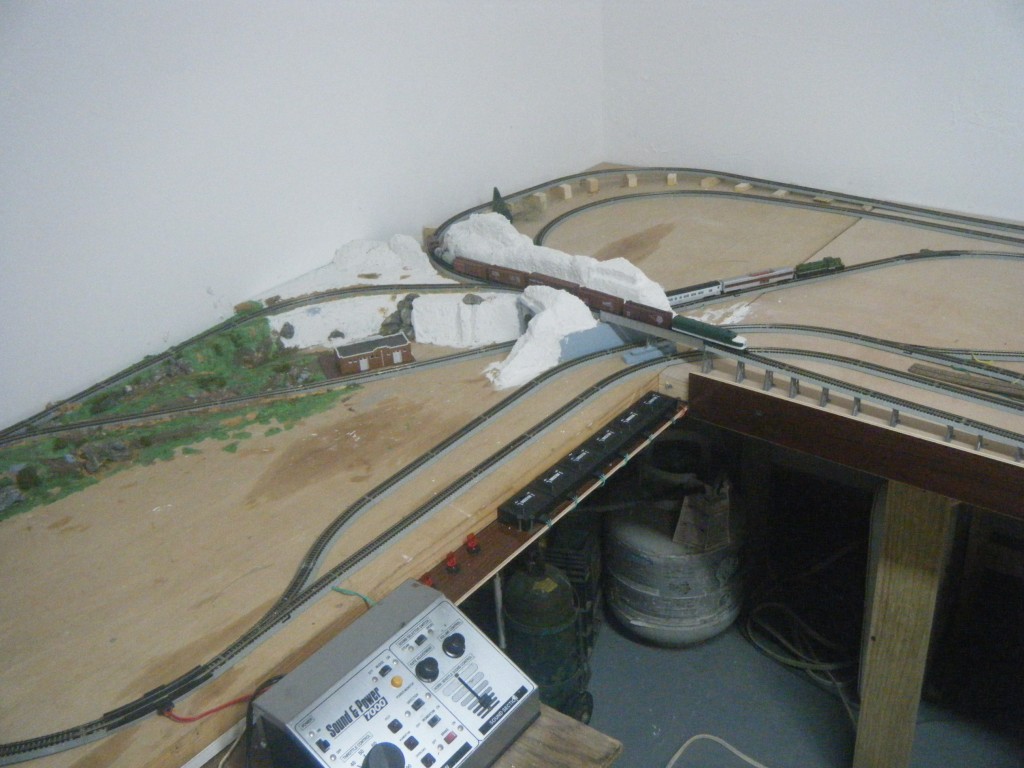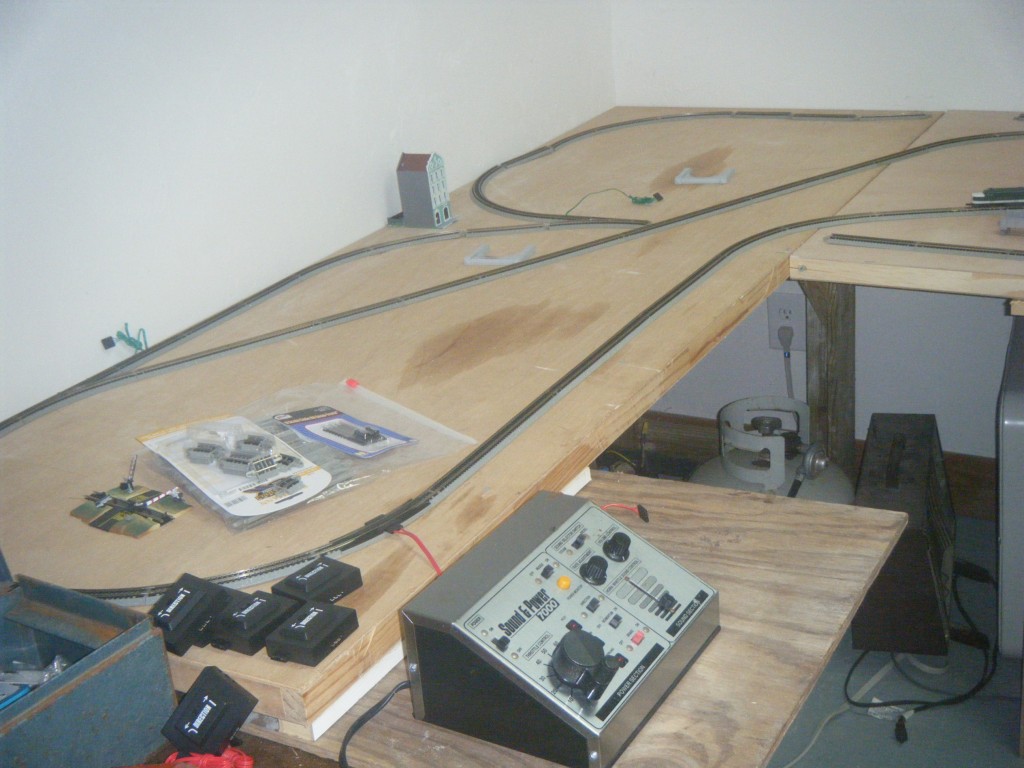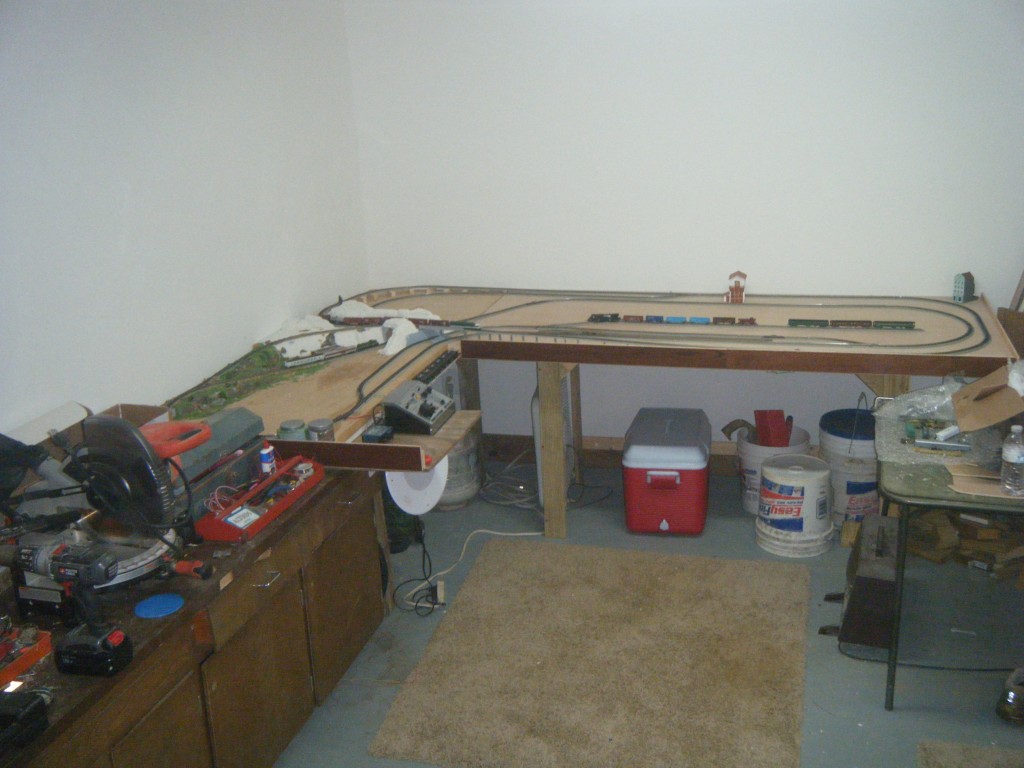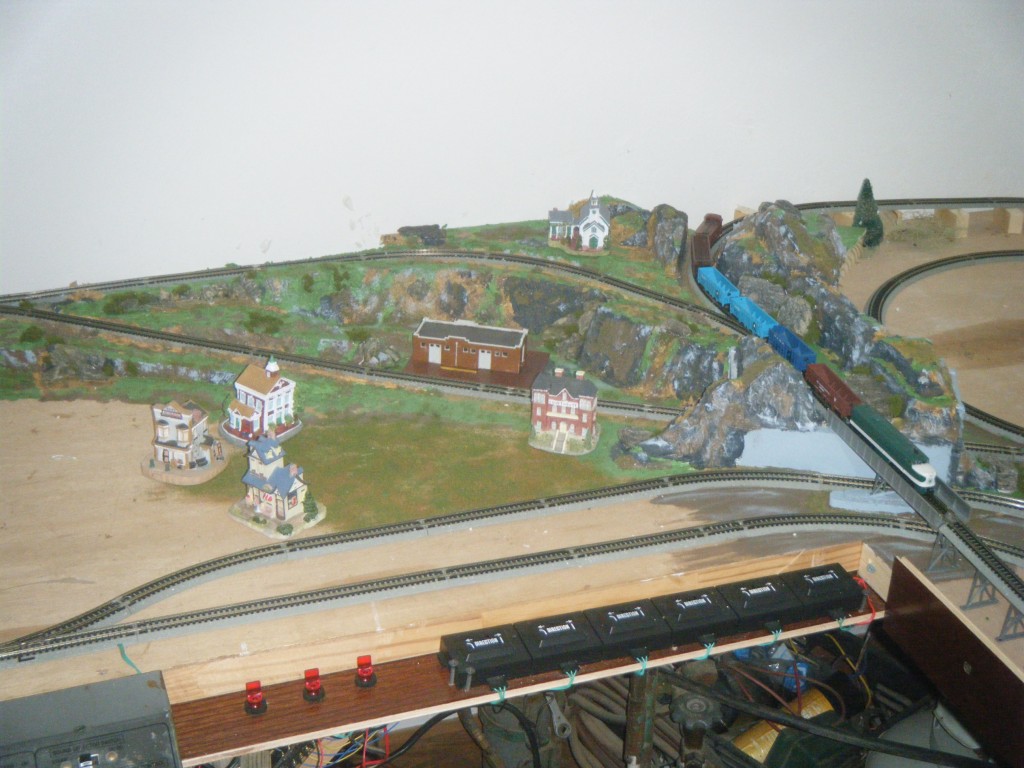“After mostly finishing my other N-Scale 4 X 8 layout in about 12 months, I realized where this was taking me. So I am trying a new approach.
To keep it simple and allow for changes or to completely start over I designed this train table using light weight, hollow core interior doors which can be added to or rearranged later. I chose Bachman EZ track and adjusted it until it works great, all in about 2 days.
Although using EZ track limits my track radius and shapes it seems worth it to be able to change the whole thing when I finish this one. Additionally, the switches are internally operated, saving you from ugly switch motors or under the table mechanisms.
The foam formed hills mostly just sit on the top and any attached items are w/liquid nails which will scrape loose if necessary. I will be adding buildings, scenery and yard track until I run out of space and then either add another door or start over w/a new track design.
The layout features two independent loops or one very long interconnected loop, a long passing siding and soon a roundhouse and RR yard.
It can be powered by DC divided into two blocks with isolation switches, as it is now or DCC when I buy new locos.
Please excuse the workshop mess.
Ed”
“Hi al,
Thanks to all who liked my latest tips, Eric asks if the log carrying men were especially made in that pose, well no they are just 2 of the workmen which come unpainted on a sprue in a DAPOL kit. I don’t know if they are available in other countries but in the UK they are a very economical way of populating a layout. I may have removed an implement that they were holding so their hands were free. I did the same with the guy steering the barge.
I now have a request. Has any one made a baseboard out of foam board including the bracing?
I would like to build a micro narrow gauge layout just using foam board, no wood. It would be a max of 2×1 feet. Would it be feasible??
Happy modelling
Alan”
And Dangerous Dave has been spending his money again:
The very latest ebay cheat sheet is here.
That’s all for today folks.
Please do keep ’em coming.
And if today is the day you get going on your layout, the Beginner’s Guide is here.
Best
Al






Hi Al,
Here is a quick reply for Alan’s query regarding using foam panels.
I have a small (6 x 3) n gauge set up on a white expanded polystyrene sheet. It works fine but needs edging and underside bracing as the sheet is very fragile. I also tried a standard 8 x 4 sheet of three inch thick insulation board. This I was not happy with as you cannot anchor point motors etc. without adding a solid sub structure. Reverted to plywood and much happier with it.
Hope this helps.
Happy modelling,
John
Marvellous! AND, lots of room to build stuff!
Alan, I am building a oo gauge 8×2 branch terminus layout for my grandkids on a piece of 50mm thick Xtratherm foam board. There are no braces and this board has been in my garage over winter without distorting. I suspect that maintaining the foil covering is key to that.
I am cutting pockets for the 4 turnouts (mounted on thin ply) so I can fit Seep point motors underneath. I have not pulled off the facing foil as this stops dust and I have covered the edges with duct tape for the same reason. I therefore think a micro-N layout of the size you want is very do-able. If you went thinner than 50mm, you may have more stability problems.
Hope that helps.
Hi, Dave, what a nice model that is, very impressive, you have a wonderful eye for detail in your layout.
Regards.
Ron.
Hi, Ed, some good tips there, thankyou.
Regards.
Ron.
Replying to Alan and his query about a micro narrow gauge layout, I built one last year for our local model train show. It was a T Gauge layout that fits into a briefcase and measured 18 inches by 13 inches and I used insulating foam board, not the white expanded polystyrene foam that’s used in packing. I think its called extruded foam and its is harder, and denser, and can be cut with a knife and shaped with a surform tool. I used a serrated bread knife, not saw-toothed but scalloped. The layout called “Briefleigh” was featured here in Al’s newsletter but unfortunately he posted the wrong info with the photos so there were no details about the layout itself.
Apologies I see my keyboard is playing with a stuck ‘t’! My query should read –
Hi Ed, can you let me know what you mean by ‘switches internally operated’? I’ve only see points / switches with motors on the side, or underneath, so I am unfamiliar with ‘switches internally operated’ types.
Thanks, Julian
Very nice layout and well planned! I love the Southern motive power … Serves the South! Thanks for sharing!
Re Alan’s question about foam board. There’s a narrow gauge layout of a gasworks scene in 009 which is bigger than you had in mind, constructed from foamcore for the base, with vertical foamcore strips underneath as bracing.
It seemed to work well and I think was taken to shows and modellers’ meets.
Good luck, please post pics to inspire the rest of us.
yes you can us ink or blue foam for your base. lok at freerails.com ad te moggollion railroad which is an outdoor railroad built out of fom sheets of foam.
key board is going bad pink or blue foam 2″ to 4″ not much bracing is needed
Ed your track plan looks like a good one giving you plenty of scope …well done
How do you fix N gauge trak to ply wood
Good job, I like the idea of being able to change things easily especially since you finished so quickly.
I built my table from two inch foam laid on a grid of 1X3 lumber but I think it is stiff enough to do foam alone in such a small size as one foot by two feet.
Alan
I think it would be feasible to build out of foam board. I have a diorama on a foam board base that is 8″W x 12″L & 3″ deep with no sagging. I used the best 1/4″ foam board I could buy. It is very stiff. Built just like a wood module. I would suggest a cross brace at the 1 foot mark on the 2 foot length. Build just like a wood module, but use foam. Legs are made the same way. You did not say how high you want it to stand. I have 4″ legs on mine. Legs are L shaped. Hope this will help.
Hat
As usual, Dave has outdone himself again. A beautiful new engine! I never tire of watching Dave’s railroad. It is perhaps one of the best I’ve ever seen. Keep ’em coming, Dave.
Hi Ed i have never used foam, why is foam used is it to keep the noise down lighter and easier to use. the door concept i use as with other modellers we can put together a nice layout. also i put small wheels on the under neath easier for children to put it under their beds.loved the video Dave and the nice new train, is it a new train every year or every new layout concept, mine is every year and i am due might copy yours.
Hi Ed, Good start to your N gauge, look forward to seeing it develop.
Alan. I have used the insulation foam slabs my N gauge layout, as I wanted lots of hill & valley topography. Two thicknesses of 2″ foam board stuck together with Evostick – left the foil on. It is 5ft by 2.5 ft with edges protected by glued on 3mm MDF, plus wooded corner angled beading. Track bed is 3mm MDF strips glued down with Evostick, then with cork on top glued down with Copydex latex adhesive. Track glued down as well with Copydex – It stick well and you can lift the track later if you need to by sliding a thin bladed underneath – take care not get the glue on the moving parts of the points ! I have also build up hills using the expanding “foam in a can” – works well but keeps on expanding for quite a while – so be sparing with it !
The whole lot is very light and has stayed stable for two years now – been in abeyance due y=to pending house move and subsequent house renovation after the move – about to get back to it.
Happy modelling – Gavin
SO FAR BEAUTIFULLY DONE.
I too have seen a successful and quite large exhibition layout made of foam but with plywood framing round the edges for protection and to allow bolting sections together. It was a lovely bit of carpentry using quite delicate section timber, good if you’re that neat with wood (no, I’m not!) and very light if you need to move it single handed.
Dave, that “Merddin Emrys” blue livery dates from 1994, worked like that
for many years I believe.
Keith Westgate, how you fix track to ply is to cut the point off the track pins so they are about half length and pre-drill a tad smaller, and to hammer home use a pin punch. I know cutting the sharp point off sounds insane but it seems to work a treat.
Rod
The only problem I see is how well will it stand the test of time, especially if small children are going to be using it. I had considered using it myself on the layout I just started in N scale. I decided against it for just that reason.
Good luck with your project. Bob
Alan,
I have built an On30 layout entirely out of foam board..
The layout is an Inglenook and is 12 inches wide by 40 inches long.
Pictures are available and I have pictures of how it was braced.
For amusement, I am now building a layout that has been entirely framed with cardboard from two shipping boxes…
It is another Inglenook made with some leftover track from other projects.
The most difficult challenge so far has been removing the corrugations from the “sky”.
John
One more thought on foam board….
20 years ago I built a simple layout (loop and two spurs… Roundy, Roundy…
That layout was 42 inches wide and 66 inches long
I used Bachman EZ-Track and my daughter crawled all over it…
The track survived and the baseboard survived… The scenery; not so much.
Built well, a foamboard layout can be remarkably robust.
John
I saw a t scale micro set up used in a coffee table to permanently run a figure 8 track and it looked awesome the video is available on you tube to view just type in t scale model railway
thanks alln
Working with the hollow core doors is a great idea because not only is the layout portable but can be in any configuration your imagination will take you. I started out this way with 3 doors and ended up building a more permanent layout on my own. Nice ideas Ed!
I have built an n-scale railroad on a 3 x 8 slab of 2 inch thick pink extruded foam board which sits on a metal workbench frame that is 2 x 6. It is very solid and no crossbracing is necessary.
The stuff is very strong.
David
am n gage train set
I suspect that Ed’s idea about using “foam board” is using board made from two facings of paper with foam between, rather than the thicker, sometimes foil backed insulation sheets. There is also a tougher version of this called Gater board. I have used foam board often in displays, containers, trays and yes, even models! The paper faced board will warp, but is strong and doesn’t de-laminate. Gater type board will also warp, but not as much. I would suggest adding a border around the underside about 2″ deep made of foam board, and perhaps a few cross pieces underneith (easily glued using white glue), and I believe you will have a very strong, capable place for your layout.
Hi Ed,
Just started my new N layout after having it packed away for 20 yrs. I have 12 engines, 44 rolling stock and 49 building / structures. I have purchased all new track and switched. Old track was Atlas flex. Only comment I have with what you wrote is I am using Kato Unitrack. I personally prefer it over Bauchmann EZ Track. I will send pics to Alstair after I have progressed a little more. Looks like you have a great start.
Member of the KV&EC Train Club, Sun City Huntley IL USA
Message for Dave H, Hi Dave, would it be possible to date your videos as I see so many of them at different times from so many other sources that I really am not sure where you are at with your layout.
Regards
Mike
Hi Ed,
Magic layout; any chance of a plan. I have a similar shaped area to work with and have been agonising over what to do.
Best regards
Peter
Alan: For the size of 1x 2′ I would think that 2″ pink insulation board would be strong enough to use without support. I have a 4×8′ 2′ pink foam layout that is only supported by the edges and is rigid. A lot of places, however, don’t carry the 2″ pink stuff. You might have to look around.
Have fun! Regards: Ray, USA
What is done to keep the cars on the tracks, I had an N scale layout a few years ago but abandoned it because the cars would always derail
My 3.5 x 7.5 n layout is 2” foam with mdf frame. Tilts up to allow standup to wire dcc and turnouts. They are mounted on wood piece with motor under. Base Has two cutouts with removable foam inserts for access when needed. Very flexible.
I never know which of Dangerous Dave’s layouts is his latest.
Andrew in Oz
Is mountboard called Foamcore in America?
foamcore board in america usually refers to an inexpensive soft extruded foam core typically 1/4″ thick, with coated paper stock on both sides. It is often used for photo mounting using pressure sensitive adhesive sheets, art projects, temporary signs etc. It is fragile: dents and breaks easily.